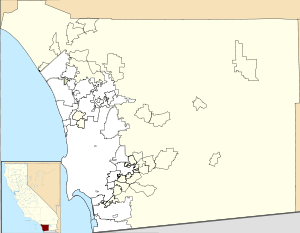Aztec Bowl (stadium)
|
Aztec Bowl | |
|
Aztec Bowl | |
   | |
| Location |
5300 Campanile Dr., San Diego, California |
|---|---|
| Coordinates | 32°46′33″N 117°4′16″W / 32.77583°N 117.07111°WCoordinates: 32°46′33″N 117°4′16″W / 32.77583°N 117.07111°W |
| Architect | multiple |
| Architectural style | Mission/Spanish Revival |
| Part of | San Diego State College (#97000924) |
| NRHP Reference # | 94000402[1] |
| Added to NRHP | September 4, 1997[2] |
Aztec Bowl was a football stadium (a Works Progress Administration project) on the San Diego State University campus in San Diego, California.
History
Aztec Bowl hosted the San Diego State University Aztecs football team until they moved to Qualcomm Stadium in 1967. The stadium held 12,592 people at its peak and cost $500,000 to build. It was dedicated on October 3, 1936 before 7,500 people, after being completed earlier that year.
The stadium was initially supposed to be expanded to 45,000 seats but was expanded only once, to 5,000 seats in 1948.
Current use
Currently Viejas Arena (formerly Cox Arena), the school's basketball arena, sits on the site of the stadium.
National Register of Historic Places
Aztec Bowl is listed on the National Register of Historic Places:[3] The old concrete bleachers of the football stadium were not demolished when the new arena was built. John F. Kennedy, then the President of the United States of America, gave the graduation commencement address at San Diego State University on June 6, 1963.[4][5][6][7]
As a nation, we have no deeper concern, no older commitment and no higher interest than a strong, sound and free system of education for all. In fulfilling this obligation to ourselves and our children, we provide for the future of our nation-and for the future of freedom.
(Historical Video)— John F. Kennedy, President of the United States of America, Graduation commencement address to San Diego State College (San Diego, California), June 6, 1963
.
In commemoration, the arena was built on top of the steps from which people listened to President Kennedy. The bleachers can be clearly seen from the arena's parking lot on the outside and in the storage areas under the arena seats on the inside of the arena.
There has been a request to remove the stadium from the National Register of Historic Places.[8]
See also
References
- ↑ National Park Service (2010-07-09). "National Register Information System". National Register of Historic Places. National Park Service.
- ↑ National Park Service (2009-03-13). "National Register Information System". National Register of Historic Places. National Park Service.
- ↑ "Historic Buildings of San Diego State University". Infodome - SDSU Historic Buildings. San Diego State University. Retrieved 2009-07-30.
- ↑ Forty Years Later, the Magic of JFK Lingers on the Mesa, Coleen L. Geraghty, SDSUniverse (May 12, 2003)
- ↑ SDSU Library, Aztec Bowl: History of San Diego State University (accessed Jan. 16, 2009)
- ↑ John F. Kennedy commencement address (June 6, 1963), SDSU Special Collections (video)
- ↑ Diego State University, Library & Information Access, "President John F. Kennedy's 1963 Commencement Speech at San Diego State (video and audio archive)
- ↑ "Pending (Not Yet Acted Upon) List". National Park Service. April 21, 2012. Retrieved 27 April 2012.